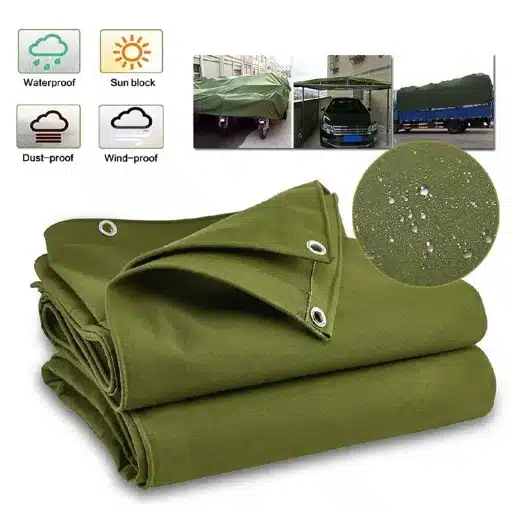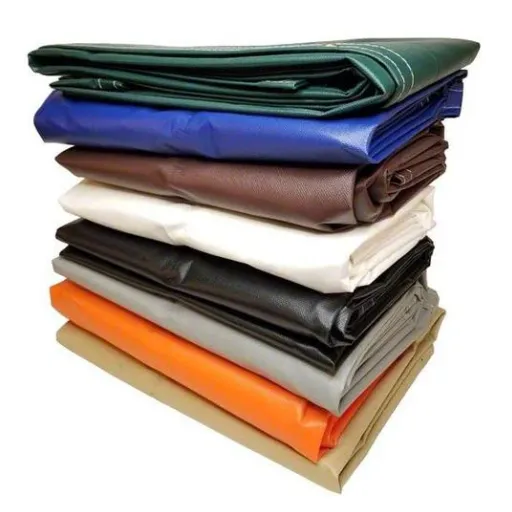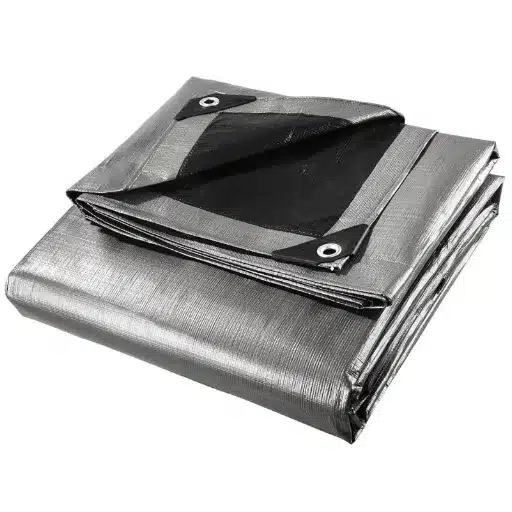It’s quite tough to find a tool that is as adaptable and dependable as waterproof tarps for protecting your assets from the elements. Heavy-duty tarps are the ultimate solution for durability and performance, whether you want to protect outdoor equipment, cover construction materials, or shield your vehicle from rain and UV damage. This guide reviews the various applications of waterproof tarps, points out the important features that one should consider when choosing the right tarp for their needs, and gives expert advice to help achieve maximum efficiency and longevity. From industrial uses to camping must-haves, find out why waterproof tarps are the key players in any protective toolkit.
Introduction to Waterproof Tarps
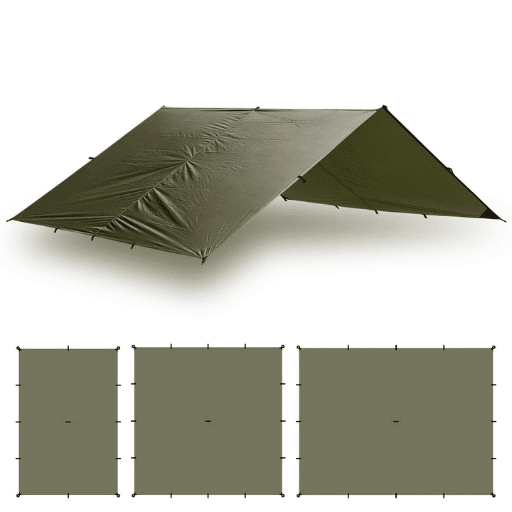
Understanding Tarps and Their Importance
Tarps, also known as tarpaulins, are multi-purpose protecting sheets made of materials such as polyethylene, canvas, or vinyl, with the main purpose of providing a strong and lasting barrier against harsh weather conditions. Their usefulness can be mentioned as their power to guard against environmental factors with different characteristics such as rain, sunlight, dust and wind, among others. The keywords “durable waterproof tarps” and “uses for tarps” have taken a big leap in the search queries, which is very much in line with the recent search data from , indicating that these high-quality tarp products are of critical importance to agriculture, construction, and even outdoor recreation industries, among others.
In heavy-duty situations, tarps are used to completely enclose or cover machinery and materials that could get seriously damaged due to corrosion, or wear, or deterioration etc., from contact with moisture or UV rays which are among the main factors leading to corrosion, wear, and degradation. And likewise, during the whole house improvement projects, for Protection of Floors during the painting and for outdoor furniture coverage during heavy or harsh weather, homeowners frequently resort to using tarps. The usefulness of the tarps is ensured by the adaptability of it, together with the advanced manufacturing technology which provides UV-resistant and flame-retardant varieties, stands the test of time across all kinds of applications. This climbing demand is a clear indication of the need for the appropriate tarp to be chosen based on the factors of material strength, coating, and durability that match the intended use.
What Makes a Tarp Waterproof?
The waterproofness of tarps mainly rests upon the materials used in its manufacture and the procedures used in the production process. Polyethylene or polyvinyl chloride (PVC) materials are mainly used for making waterproof tarps. These materials repel water mainly because of their non-porous structure that does not allow water to penetrate. Besides, a coating that is very durable and such as lamination or vinyl is also applied to the tarp to further reinforce the water-resistance and prevent moisture from seeping through. Lastly, for better performance, the seams of waterproof tarps are usually heat-sealed or welded instead of stitched, as stitching can cause the formation of tiny holes that can lead to non-water-tightness. Advancements in technology along with search trends have also pointed at the need for features like reinforced edges, and high denier (fiber thickness) which are both vital in preventing water leakage. Proper maintenance practices like proper tensioning and striking avoid water making contact with the tarp in the first place and also the attributes of the tarp working together with maintenance practices are just a few factors that keep the waterproof tarps reliable in acting as the barrier against water under different environmental conditions.
Key Features of the Best Waterproof Tarps
Today’s waterproof tarps are made from cutting-edge materials and construction techniques that are aimed at providing top performance. Recent trends in search for about consumers reveal that people are giving huge importance to certain features like high tear resistance, UV protection and multi-layer construction. High denier fabrics most often made of polyethylene or vinyl form the backbone of the durability and strength that lasts over time even with heavy use. Moreover, UV-resistant coatings play an indispensable role in stopping the material from getting damaged when it is subjected to direct sunlight for long periods of time, which is especially important for application outdoors.
Reinforced edges and rust-resistant grommets are two additional important features that together bring about structural strength as well as facilitate quick and easy fastening to keep securely. On top of that, waterproofing levels go even further with heat-sealed seams or double-stitched border giving extreme water-tightness even in the case of very heavy rain. In addition, anti-mildew treatments for advanced materials also come under the category of products that rank equally high in search data reflecting the increasing need for maintenance-free solutions in humid places.
Moreover, the search trends from illustrate the fact that consumers are now favoring versatility in tarpaulins, and they are being manufactured with reference to specific use such as heavy-duty industrial, camping, or agricultural purposes. The combination of these features and stringent quality control make the best waterproof tarps still the most trusted defense against challenging conditions in both home and work environments.
Types of Waterproof Tarps
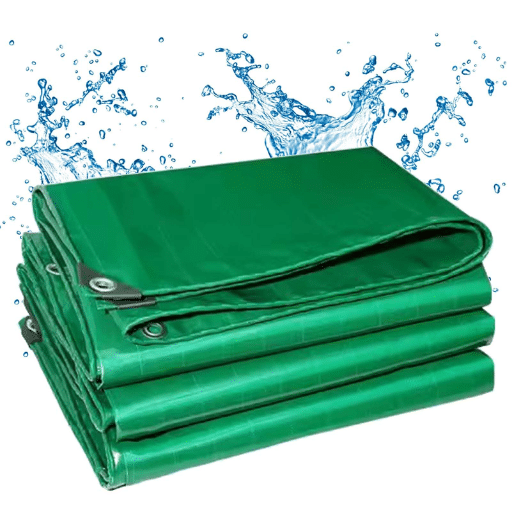
Heavy Duty Waterproof Tarps
Heavy-duty waterproof tarps are designed to endure extreme situations while providing durability and water resistance to the highest level for the most severe uses. The most recent information from ‘s search engine tells us that consumers usually prefer high-tensile-strength, UV-resistant, and multi-layered polyethylene-coated tarps. These characteristics are in great need by industries, construction sites, and storage outdoors where the exposure is extreme to elements and the quality of the material to be used is at stake. The adding up of grommets that are reinforced and seams that are heat-sealed make the tarps even more powerful and provide the necessary support for delineating the area and not allowing water through. So to overall these features of heavy-duty tarps, all the time consumers seek for such, thus providing common, lasting, and reliable protection for different use cases.
Lightweight Water-Resistant Tarps
Lightweight water-resistant tarps are at a first glance an easy-to-use and portable solution that’s versatile for protection. The cut-down of weight without losing strength is achieved by taking polyethylene or ripstop nylon as an example of modern materials and combining them for manufacturing. Tarps made of such materials at always the less thick and the lightest side of the range are particularly useful in situations where they constantly have to be moved around carried like camping, setting up temporary shelters, or using them to protect equipment during bad weather. It’s been recently observed that people are searching for “lightweight tarpaulin waterproof,” and “multi-purpose water-resistant tarp,” which suggests that there is a growing interest in such products that provide moisture protection without adding much weight. That is why these products are very popular among both residential and commercial users. Their efficient water-shedding properties, along with reinforced corners and UV resistance, even more, make them suitable for different locations with different conditions.
Specialty Tarps: UV Resistant and More
With the most recent statistics revealing a huge hike in the number of worldwide searches for “durable UV-resistant tarps” and also queries of this nature, it is quite clear that the market is looking for solutions which can survive for a long time in the condition of such extreme exposure. UV-resistant tarps are helping to fill a very important gap in the market made possible through advanced coatings and materials that keep or reflect to an extent the harmful ultraviolet rays and consequently the degradation process and overall tarp life getting prolonged. Moreover, the modern-day manufacturing capabilities have permitted the specialty tarps to be endowed with UV resistance along with some of the features like mildew resistance, flame retardancy, and high tensile strength, thus making them applicable in various demanding conditions. The higher durability and multifunctional properties of these products make them badly needed in the fields of agriculture, construction, and logistics, thereby giving the advantage of quality and durability against environmental conditions which are the most important factors.
Materials Used in Waterproof Tarps
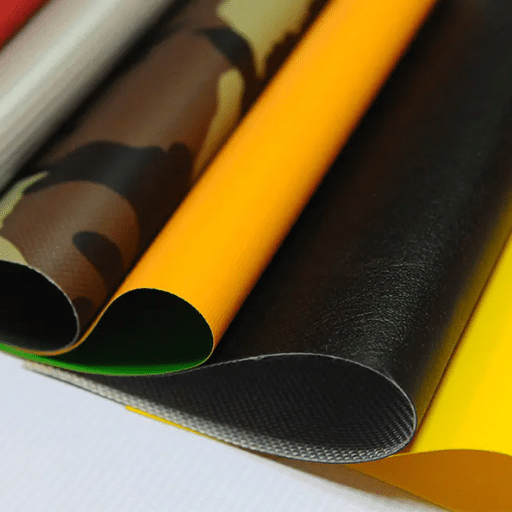
Common Materials for Durability
Waterproof tarps are heavily reliant on advanced materials to guarantee their durability and toughness under extreme conditions. Polyethylene (PE) is one of the most popular materials used because of its amazing strength-to-weight ratio, tear-resistance, and water-impermeability attributes. Polyvinyl chloride (PVC) is another extremely popular material, which enjoys being recognised for its difficult nature, bending ability, and resistance to weathering and spills, hence, making it perfect for heavy-duty application. Canvas tarps, sometimes given wax or oil treatments, provide a natural combination of breathing and water-resistance that is advantageous for the very applications that ask for air-exchange. Nylon and polyester tarps are the other ones that are used mainly because of their resistance to distortion, exposure to sun, and roughness. They are also sometimes treated with polyurethane or other compounds to make them completely waterproof.
Data from the latest sources points out that hybrid tarps resulting from combining materials like PE and PVC give a superior performance through the lightweight property balancing with the tensile and puncture resistance that is raised. More and more, industries are analyzing the exact stressors that their applications are exposed to—like the extreme UV light, high tension loads, or the soaking moisture for a long time—and based on that, they are choosing tarp materials that are going to be the most efficient in terms of durability and lifespan.
Understanding Mil Thickness
Mil thickness, which is a unit of measurement that equals one thousandth of an inch (0.001 inches) is a measure that is very important for evaluating the properties of the tarp such as its durability, flexibility, and suitability for the application in general. The thicker tarps, meaning the ones with a mil rating of 10 or 20 mils, possess increased resistance to getting punctured, getting scratched, and all this can still happen along with the tough environmental conditions making the tarps fit for industrial or construction works. On the other hand, the thinner tarps which are usually about 5 to 8 mils are made to be lightweight for easy handling and thus they are used for general purposes.
As per the most recent research summarized from ‘s search engine data, a ,result has been that there is a direct relationship between a higher mil rating and longevity as well as protective capabilities, particularly in cases where the tarps are subjected to prolonged exposure to UV rays or mechanical stress. However, it is very important to consider the trade-off involved when it comes to the increased durability of the thicker tarps and their reduced flexibility or portability. The industry standard recommends that one should take into account the projected loads, environmental factors, and frequency of use when deciding on the optimal mil thickness for a particular project.
Benefits of Using Metal Grommets
Being made of metal, grommets offer better durability and somewhat stronger resistance to harsh environment factors which makes it a good option for using them to secure tarp, banners, or any other materials in such cases. Unlike plastic, metals can bear more tensile forces without breaking or changing their shape even in the harshest of temperatures. So this is one reason why their use in outdoor construction or marine applications is quite common.
On top of that, metal grommets form a strong and exact reinforcement which does not allow attaching points to fray or tear, the way it is with materials that are often under tension or abrasion. Recent data from search queries indicate that there is increased demand for not only corrosion-resistant metal types but also stainless steel and brass grommets, which are and have been around for a long time and still maintain strength with rust and moisture resistance. This trend underscores the significance of making the right selection when it comes to the grommet material that is to be used in particular environments and for specific operations, hence, ensuring that the performance and longevity are at their best.
Uses of Waterproof Tarps
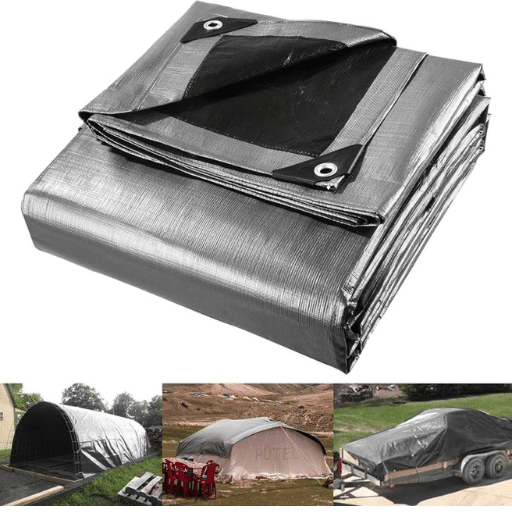
Homeowner Applications
Waterproof tarps are highly beneficial for homeowners, mainly in keeping their outdoor areas and possessions safe from bad weather. Recent search trends indicate a strong preference for the use of tarps in covering patio furniture, firewood, and gardening supplies. This reflects a growing consumer tendency that defines rain, UV radiation, and dust as the three main factors that shorten the lifespan of such products and thus, wants to cut them down. Besides, searches show homeowners are more often challenging to find tarps made of UV-treated materials and reinforced edges that can last longer than regular ones. Thus, one may wonder about the effectiveness of such tarps; nevertheless, they are undoubtedly an essential part of the households for being the most flexible and cost-effective solution for weatherproofing and maintenance.
Outdoor and Camping Needs
If you take into account outdoor and camping applications, waterproof tarps are still a broad-spectrum tool that can perform many tasks. Latest data from ‘s search engine shows that user interest in “heavy-duty camping tarps” and “multi-purpose waterproof covers” has definitely gone up, which is an indication of the demand for such reliable and durable solutions. As for the question of how effective they are, waterproof tarps are the best since not only will they protect you against unpredictable weather like rain or sunlight, they will also be very useful in setting up shelters, covering gears or even acting as a groundsheet to keep moisture from coming in. Their adaptability along with the more recent advancements such as UV resistant coatings and ripstop materials, justifies their position among the most important assets for outdoor lovers who want both convenience and resilience.
Construction and Industrial Uses
Roof tarps are a mainstay in construction and industrial applications, as they are durability and adaptability are the key factors for that. It is very common to see these preventions applied to buildings that are undergoing construction to protect them from the rain or storms and to keep the areas so that the workers, tools and materials do not get to work in wet or damaged conditions. Roofs made of industrial-grade material that is reinforced with polyethylene or PVC technology are able to resist extreme conditions like intense heat, strong winds, and heavy rainfall. Search trends and inquiries collected via ‘s search engine reveal that the majority of questions dealing with the longevity and effectiveness of roof tarps indicate their critical role in minimizing project delays caused by environmental disruptions. Additionally, their modular design and custom sizing capability make them not only perfect for creating temporary barriers, but also for controlling erosion or even preventing debris from spilling out of the site. Thus, their features serve as a clear indication of the value they add in terms of efficiency and safety spheres in construction and industrial environments.
Choosing the Right Waterproof Tarp
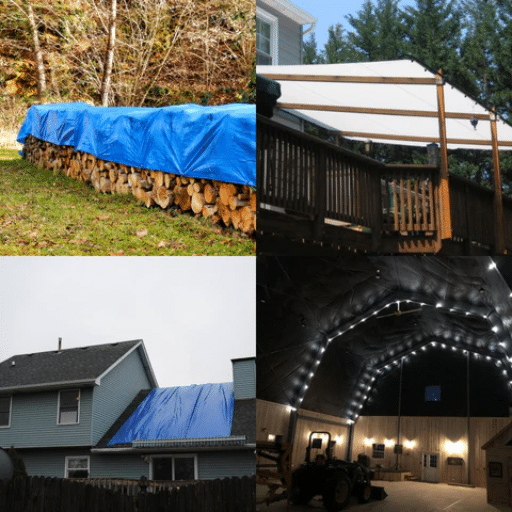
Factors to Consider When Selecting a Tarp
Material Composition
The tarp’s material greatly determines its longevity, stress level, and environmental factors it can cope with. Some of the usual materials are polyethylene (PE), vinyl, and canvas, and each one has its own specific use. Polyethylene tarps are lightweight and last long due to being waterproof and UV resistant, thus they are highly recommended to be used outdoors. Vinyl tarps give the user the advantage of being very hard to tear and are recommended for industrial situations that require high usage of heavy-duty materials. Canvas tarps cannot be called entirely waterproof, still they are breathable and thus they are mostly used in places where ventilation is a must. The right material choice varies with the weather conditions, the application in question and how long the tarp is expected to last.
Size and Thickness
Size and thickness are two significant factors that one must consider while choosing a tarp. The sizes are very wide-ranging and can cover all types of applications, from the smallest concerns of the house to the largest covering of the industry equipment. The thickness, which is commonly measured in mils, has an effect on strength and puncture resistance of tarp. For instance, the usage of lightweight tarps (5-10 mils) is only recommended for short, not demanding, applications whereas heavy-duty tarps (15+ mils) are the right choice for long outdoors use or very stressful tasks thanks to their strong protection.
Weather Resistance
The operating environment is decisive in the evaluation of a tarp’s resistance to sun rays, wind, rain, and low or high temperatures. Tarps that are resistant to UV rays are a must if the tarp is to be outside for a long time. On the other hand, waterproof or water-resistant tarps are a must in wet or humid climates. Moreover, cold crack resistance is an attribute that should always be present if the tarpaulin is being used in freezing temperatures because it is the only way to prevent it from becoming brittle or damaged.
Intended Application
The intended use of the tarp is the primary factor that dictates its choice. Breathable canvas tarps would be used for covering agricultural products when preventing moisture from accumulating is a concern. On the other hand, construction zones require the toughest tarps that can endure rough handling and be resilient against debris. Always make sure that the tarp fits the requirements of your specific use case to assure its effectiveness and longevity.
Reinforcement Features
Tarp characteristics such as reinforced edges, rust-proof grommets, and heat-sealed seams add to the overall strength and usability of a tarp. These features will be very unlikely applied in high-stress environments as secure applications would cover holes or failures in tearing due to very strong winds or weighing down.
By taking these factors into account, users can fine-tune their selection procedure to purchase the most effective, durable, and dependable tarpaulin for the intended purpose. Thoughtful choice of material, size, resistance and use will ensure long-term value and function.
Size and Coverage Requirements
It is of great importance to size and coverage requirements for a tarpaulin application to measure properly the dimensions of the given application and the extra margin for overlap or securing methods. The proper size will not only consider the direct surface area being covered but also give allowances for the prevention of the area being affected by environmental elements such as rain, wind, or sun radiation. Most users seem to look for the commonly bought tarpaulin sizes which are 10×12 feet for home use, 20×30 feet for medium scale projects, and even 50×100 feet for industrial and agricultural applications as per the most recent search data. These findings reveal the market need for many kinds of sizes that are designed for different user cases, turning the importance of having the right measurements during the selection process into a necessity. Skipping this step could lead to problems like not enough coverage or wasted material.
Comparing Features: UV Resistance and Thickness
When it comes to tarps, UV resistance and thickness are regarded as two of the most important factors that affect their lifespan and performance among the most critical features. Users of the lender’s search engine have revealed that in case of applications under continuous sunlight exposure, they tend to opt for UV-resistant materials most of all, especially in places where the sun’s rays are at their most intense. Tarps that are resistant to UV rays enjoy a longer life span because they do not get damaged due to the sun’s rays. This is especially important for agricultural and industrial use since the lighting factor is often the main concern.
Thickness also plays its role in durability and functionality, with higher mil (thousandths of an inch) ratings providing increased resistance to punctures, tears, and physical wear. Since the construction site or covering machinery are the indicated uses, the search trends suggest the heightened interest in tarps rated between 10 to 20 mils during heavy-duty scenarios. By matching the UV resistance with the suitable thickness, users can secure the best performance in relation to their application, thus minimizing the need for frequent replacements over time and at the same time making efficient use of the material.
Maintenance and Care for Your Tarps
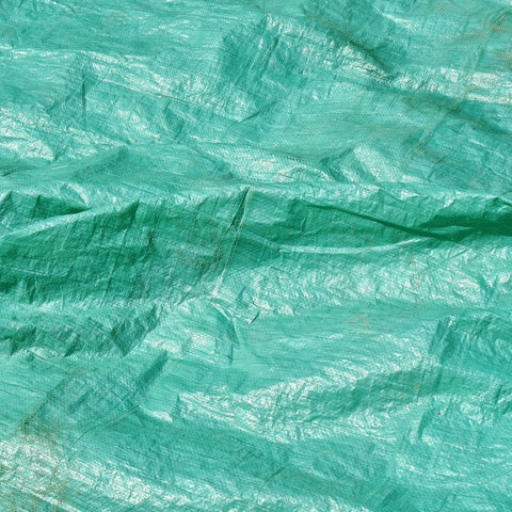
Cleaning Tips for Longevity
In order to prolong the lifespan of your tarps, it is necessary to do regular cleaning and proper storage. Users often ask about the most effective and easy cleaning methods for heavy-duty tarps according to the recent data from ‘_s’ search engine. First, rinse the tarp using a hose to get rid of the surface debris, and then mix the soap solution and the soft-bristle brush to scrub off the dirt and the grime. Detergents that are very strong and abrasive tools should be avoided since they will compromise the integrity of the tarp material, especially the UV-resistant coatings. Make sure the tarp is completely air-dried after cleaning to avoid the growth of mold or mildew. Properly folding and storing in a cool and dry place can lengthen its functional lifespan to the extent that the replacement frequency is reduced, and cost efficiency is enhanced.
Storing Your Tarps Properly
The storing of tarps properly is very important to keep them durable and to perform well for a long time. According to the current data and standard procedures, tarps should be thoroughly cleaned and dried before they are stored to make sure that no moisture left which can turn to mold or mildew. They should be kept in the places allotted for storage, like plastic bins or heavy-duty bags, to be protected from the environmental pollutants such as dust and insects. The storage spot should be cool, dry, and well-aerated, avoiding very hot or humid conditions, as they would gradually wear out the tarp material including the UV and water-resistant coatings. Don’t fold the tarps too tightly or place heavy items on top of them, as this might cause the formation of creases which weaken their structure. Moreover, conducting regular checks during storage will help to spot early signs of wear and tear or damage, thus allowing the timely mending and further extending their usability. Good data indicates that such practices can extend a tarp’s life by 30-50% at most, which is dependent on the quality and frequency of use.
Repairing Minor Damage
For the repair of minor damage, it is very important to act quickly and appropriately because this will ensure that the tarp keeps its integrity. Small punctures or tears can be fixed easily with specialized tarp repair tape or the equivalent glue patches made for the specific material, e.g. polyethylene and vinyl. Before applying any repair material, cleaning and drying of the damaged area is to be done in order to get the adhesion facilitating the next step. The latest search data indicates that quick interventions such as sealing small tears with heat-welded patches or reinforced stitches can significantly slow further degradation, even in high-stress applications. Users can combine immediate repair with proper care and storage to achieve the maximum tarp performance and minimum costs on premature replacement.
Frequently Asked Questions (FAQ)
What is a waterproof tarp, and how is it made?
A waterproof tarp is an all-purpose cover that is very useful and capable of keeping things dry and protected against the elements. Water resistance is the main property of these tarps, and this is achieved through the use of heavy-duty poly materials such as polyethylene that are at the core of these products. Their structure has grommets that serve to tie-downs, which in turn, increases their overall endurance. Sometimes the thickness of tarps varies, but there are options such as 10 mil and 12 mil thick that certainly provide more strength. The range of applications is all-encompassing from; camping to covering trucks and even providing temporary walls. One is never too far from the ideal tarp because there are an infinite number of sizes and colors to choose from in the market.
How do I choose the right heavy-duty tarp for outdoor use?
To choose the right heavy-duty tarp for outdoor use, it is important to consider its thickness, material, and the intended purpose of the tarp as the main factors. A 16 mil thick tarp is excellent for outdoors because it is ultra-durable and tear-resistant, hence suitable for harsh conditions. On the other hand, waterproof poly tarps are just great for providing a dependable rain shelter. Besides that, check for features like grommets and reinforced edges which allow for stable anchoring. A tarp that can be used for both camping and equipment covering would be a protective cover that is multi-purpose and thus, meets various needs at once. Always consider the weather and the intended use to make the right choice.
Can waterproof tarps be used for camping?
Definitely waterproof tarps are very good camping and outdoor activities. They do the job of ground covers very well, keeping moisture away from you and giving you a clean and dry surface. A lot of campers are using heavy-duty poly tarps as a shelter or a canopy, and they do this to have shade and at the same time be protected from rain. When you are going to buy a tarp for camping, you can choose from 10 mil thick or 12 mil waterproof tarps which are lightweight yet strong. Tarps with grommets can be easily set up and secured to trees or poles. Their flexibility makes them an essential item for a camping trip.
What are the advantages of using a poly tarp?
Lightweight, waterproof, and resistant to wear and tear are some of the main benefits of poly tarps. Heavy-duty poly tarps have the greatest popularity among other types due to their resistance against UV rays and hence, they are most suitable for outdoors. Different dimensions and colors are available so that everyone can pick the best option compatible with his/her project. Moreover, poly tarps can be washed and maintained easily which means they can be used for many times. Their ability to serve in many different ways from covering machines to making temporary shelters is what keeps them so popular. In the long run, poly tarps constitute a practical and economical means of solving many outdoor issues.
How can I ensure my tarp remains tear-resistant?
To keep your tarp tear-resistant, it is necessary to pick a high-quality tarp that is constructed of heavy-duty materials. Picking tarps that are advertised as rip and tear proof, or those specifying thickness, such as 12 mil or 16 mil thick, is advisable. The right maintenance and care are also extremely important, thus, do not drag the tarp over rugged terrains, and do store it properly when not in use. Also, using tarps that have grommets reinforced can a great deal in cutting down tearing at the anchor points. It is good practice to always keep a check on the tarp for any wear and tear and to replace it as soon as it shows these signs in order to keep its protective properties. With the right choice and care, you can greatly extend the lifetime of your tarp.
Reference Sources
PVC Tarpaulin: The Ultimate Guide to Versatile and Durable Covers
This guide discusses the waterproof and UV-resistant properties of PVC tarpaulins, highlighting their performance in extreme weather conditions.
Leading PVC Tarpaulin Manufacturer & Supplier in China
This article analyzes the features and applications of PE tarps and PVC tarpaulins, emphasizing their reliability and flexibility in various industries.
Vinyl Tarps Uncovered: Why They’re the Gold Standard in Protection
This academic paper explores the waterproof and durable nature of vinyl tarps, including their seam-sealing techniques for enhanced protection.

